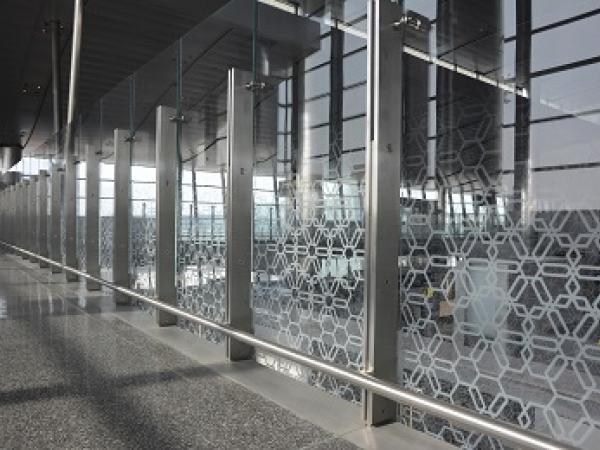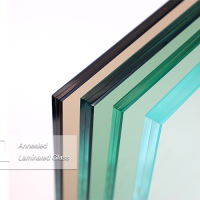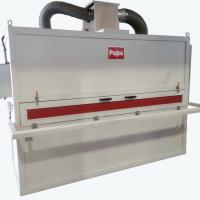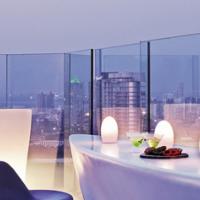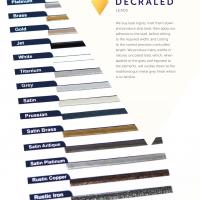When HOK, on behalf of their client NDIA Steering Committee, engaged Joel Berman Glass Studios in 2007 regarding collaboration on a project to design and create secure corridor glazing for a new airport project in the Middle East, studio founder and president Joel Berman quickly grasped the scale of the undertaking. It represented the largest, most ambitious art glass project the studio would undertake in its more than 30 year history.
A next generation airport was to be built in Doha, Qatar, and the airport itself was to achieve destination status. The project’s head architect provided his vision: while it was understood that the volume of glass would involve a production effort, each of the three phases was to be a work of art.
Functionally, the requirement was for glazing of the secure passenger corridors in three airport concourses. The glass was to be patterned in such a way as to obscure the view within the corridor up to eye level height. HOK was familiar with Berman’s work, and approached the studio with the design challenge.
While researching concepts, Berman’s senior designer, Saleem Khattak, looked to the geography and cultural history of the region. Drawing from the contemplative art of Islam, Khattak developed a contemporary interpretation of the decorative arabesque motifs that figured prominently in the region’s architectural history. In these motifs, mathematically precise geometric forms in complex patterns serve to express ideas of beauty and perfection, and symbolize humanity’s place in the universe.
Khattak developed a series of algorithmically arranged designs using polygonal shapes to convey micro, mezzo and macro patterns depending on the viewing distance. Shapes emerge from the pattern as the viewer moves toward, and away from the art. “While each concourse has its own identity,” Khattak said, “the patterns relate to each other.”
To achieve the desired obscurity, the design gradually transitions from opaque at the lower portion of each panel through translucency to full transparency at the top. “The spatial interaction within the pattern allows light to penetrate while the reflectivity of the frit ink prevents the eye from seeing past it,” observes Khattak. “This effect lends a jewel-like quality to the space.”
Joel Berman named the collection of patterns the Unity Series. “Within the studio a diverse team of talented and passionate artists and designers come together from a wide range of cultural and ethnic backgrounds,” said Berman. “We embrace this diversity; it unifies us. There is a message in the glass, and it’s a message of hope: that through the universal language of design the result will have a unifying influence on the lives of those it touches.”
“We took on a huge job. It was the biggest project we had ever tackled before,” said Ray Jensen, Seattle Production Manager for Hartung Glass Industries. “Combine that with working with three different locations and to come out as successfully as we did, it was a big undertaking and is something that we’re proud of.”
Approximately 75% of the project was laminated secure corridor glazing for three passenger concourses of Hamad International Airport and 25% was ¾” monolithic parallelograms for stairwells, escalators and balustrades.
”The project completed was in three phases over three years,” says Hartung Northwest vice president Leon Anderson. “The laminated portion of the project was cut, drilled with counter-sunk holes, painted and tempered at Hartung Oregon and then shipped to Hartung Canada where it was laminated and then sent to Hartung Tukwila where it was polished, crated and shipped by air and ocean direct to Qatar.”
“The lamination was used to create the 3D pattern effect,” added Bruce Butler, GM of Hartung Glass Canada. “The makeup of the laminated was two 48-in. x 80-in. 8mm low iron tempered lites printed with the intricate Unity Series patterns on three surfaces including difficult gradient fadeouts and then laminated with .060 SentryGlas.”
Butler continues, “It’s no easy feat to print a pattern on three different surfaces and the logistics was also a big challenge. It was an effort of constant coordination, communication, shared schedules and trying to work as one unit in three different locations in three different states/provinces in two different countries. We had a very strict and heavily document quality control criteria that we lived by. There were quality checks for dimensional tolerances, hole tolerances, pattern resolution. We precision cut everything with our waterjet. We did boil and pummel tests to test adhesion. We used color coded stickers on the tags to show that it had passed through a quality gate. Everything was recorded at each location.”
“There were four different patterns but probably two hundred distinct sizes and screens which needed to be tracked and sorted,” said Anderson. “Screens only have a certain amount of passes before they need to be replaced so they need to be managed.
We had most of the systems in place before we started. Every location had approximately a dozen different QC criteria that was checked on every piece that was tracked by a unique tag number that was followed throughout the process. Each location would pass their tag and QC information to the next location/internal customer. Any defects were stopped at a variety of quality gates and sent back to Hartung Wilsonville to be re-cut and to find out what went wrong so we could prevent additional waste.”
“We talked constantly,” said Jensen. “An employee from Joel Berman Glass Studios was onsite here for three days a week for months to physically inspect 30% of the order. Our reject rate was very low. We did an extremely good job at catching defects internally. We always shipped on time. Having the backing of the branches working together really opens up Hartung to large commercial and specialty projects anywhere.”
“It was a lot of work and at times there were a lot of challenges but when you look at the size and the scope of it, the number of problems were very small,” said Butler. “With countersunk holes, the lites could only layup one way. Other projects you can flip them around however with countersinks, it made it that much more important to make sure we got it right the first time.”
Author: Rich Porayko
*Photos courtesy of Joel Berman Glass Studios

